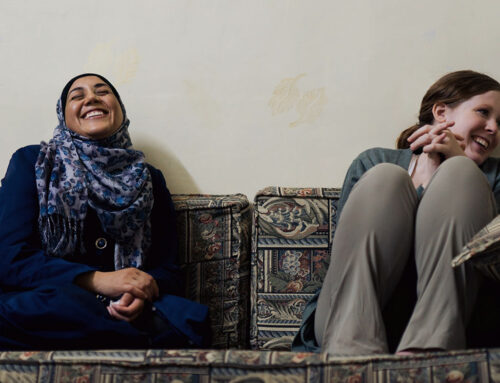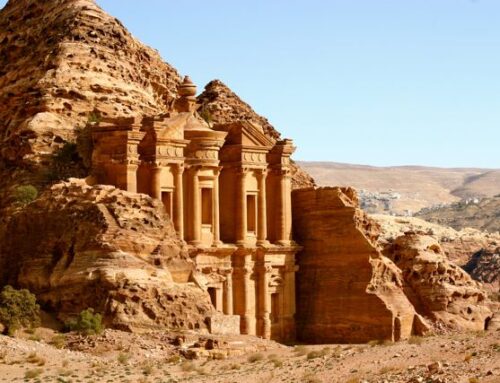The Transformative Power of Jordan
Climbing the holy mountain changed my life.
It wasn’t an especially hard climb – there are paths to the top, temperatures were high but comfortable, and my guide was kind and responsive – but Jordan can do that, delivering an unexpected bolt of emotion that knocks your preconceptions sideways.
 So when I reached the summit of Jabal Haroun, Aaron’s Mountain, dedicated to the Old Testament brother of Moses, I sank down against the wall of the little shrine at the top, took in a peerless panorama over the desert domes and peaks above the ancient city of Petra, and let the tears flow.
So when I reached the summit of Jabal Haroun, Aaron’s Mountain, dedicated to the Old Testament brother of Moses, I sank down against the wall of the little shrine at the top, took in a peerless panorama over the desert domes and peaks above the ancient city of Petra, and let the tears flow.
I was crying for myself, for my family, for the sense of achievement, but also for the place, and its power to transform – physically, and even spiritually.
Isn’t this why we travel? To see the world in all its amazing diversity of people and ideas and places and cultures, but also to challenge ourselves, to put ourselves in new situations, to test our responses, and create memories for ourselves and those around us.
Jordan is a simply mindblowing destination to accomplish all of that.
This is a tiny country. The longest drive you’ll ever do, from the capital, Amman, down to the coast at Aqaba, on the Red Sea, takes only four hours. Most places you’ll want to see are much closer together than that – yet the range of landscapes and cultures consistently impresses. You might travel in a day from far below sea level, on the sandy, sunbaked shores of the Dead Sea, to a mountain-top draped in deep winter snow.
Yet I’m willing to predict that the people might just be your biggest surprise. Hospitality really matters here. Pretty much everyone you meet will be able to chat with you in English. The people of Jordan are amazingly friendly, with no strings attached.
Come for the natural splendor – stay for the personal encounters.
It’s the desert that turns you upside down. Out in the farflung reaches of Wadi Rum, Jordan’s epic desert-scape of sheer cliffs and red dunes, it might not be the sense of isolation that changes you, maybe not even the breathtaking sunsets – but round the campfire late at night, when your bedouin host brings out the traditional one-stringed ‘rababa’ violin and starts singing songs of fearless hunters and ancient battles, you’d have to be made of stone not to be moved to your soul.
But if you thought Jordan was all desert, think again. From the fertile green hills of the north to unique nature reserves in the southern valleys, Jordan offers plenty of ways to explore the great outdoors.
Jordan’s flagship nature reserve extends from Dana village – a cluster of stone cottages on a high mountain-side with more incredible views – down the great V-shaped Dana Valley to the remote outpost of Feynan.
Whether you stay at the top, in one of Dana’s small hotels and guest houses, or down at the monastic Feynan Ecolodge, lit only by candles, far from the nearest road, the joy is to connect with the local bedouin, who have roamed these landscapes for generations. Take a nature guide, listen to stories of nomadic life, or watch the daily rituals of bread-making and coffee-roasting – these are ways of life that can help reconnect you to the simplicity and meaning of what really matters.
Or up in the highland forests of Ajloun – one of Jordan’s real eye-openers, where you can ramble through Mediterranean-style woodland of evergreen oak, pistachio, carob and wild strawberry trees, alongside olive groves aplenty. As well as roe deer, local specialist guides might help you encounter badgers, foxes, and wild boar, or birds such as jays and finches, before welcoming you into their homes for refreshment and relaxation in the peace of the forest.
But for most people Petra is the highlight of their trip to Jordan – for some, it’s a place they never forget. Famed as one of the New 7 Wonders of the World, and wreathed in mystery as one of the world’s fabled lost cities, Petra has the power to entrance. Whatever else you do in Jordan, wherever else you explore, plan some time to let Petra work its magic.
This ancient city comes as an assault on the senses. As you leave civilization behind, the sense of exposure to the elements is thrilling. The natural drama of the location, the sensuous coloring of the sandstone, the stillness, heat and clarity of light – along with a lingering, under-the-skin quality of supernatural power that seems to seep out of the rock – make it an unforgettable adventure.
Two things make Petra extra-special. First is its dramatic location, hidden from the outside world between two great parallel rocky ranges. Even today, there are very few ways into the site, keeping the sense of isolation and adventure alive.
And Petra’s sandstone facades have been gently eroded over time by the action of wind and rain, which has exposed amazing bands of colour that streak through the rock, from scarlet to yellow to purple to brown. At sunset, the sandstone facades are suffused with a lovely, pinkish glow.
The bedouin tribes that live here have special stories to tell, of an authentic connection to the grand themes of Petra’s Roman and Islamic history. Take time with them, to look past the stones and the hubbub, and find the common threads that bind us all.
And then, give yourself a challenge. Spend a day with a local family, picking olives or shopping for ingredients in the market, to cook and share a meal together. Take camels or horses out into the hills, to experience the majestic mountain sunset. Arrange to walk, again, into Petra after dark, with the trail lit by candles and a bedouin piper making music from the shadows.
Or, like me, hit the trail for Aaron’s Mountain, which rises above Petra’s jagged mountain-scape, its shrine on top lit by the first rays of the sun each morning, and the last rays of the sun each evening.
It’s not such a hard climb – but it might just change your life.





